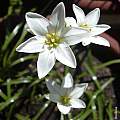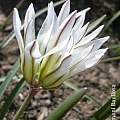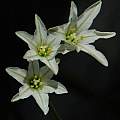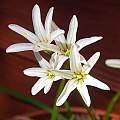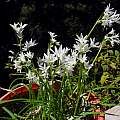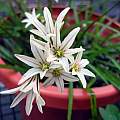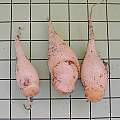Tristagma is a mostly South American genus in the former Alliaceae family (now included in Amaryllidaceae) that is related to Nothoscordum and Ipheion. The taxonomy of this genus is in question and species have had many different names. Species are found in Peru, Chile, and Argentina. In 1963 Hamilton P. Traub proposed moving Ipheion to Tristagma. In 2019 many of the accepted names of these plants are now found in the genera Ipheion and Nothoscordum. In An annotated checklist of the genus Tristagma (Amaryllidaceae, Allioideae), Phytotaxa 277: 21-35 written by Silvia C. Leuenberger and Agostina Sassone in 2016 12 species were recognized: T. ameghinoi, T. anemophilum, T. berteroi, T. bivalve, T. circinatum, T. gracile, T. graminifolium, T. nivale, T. patagonicum, T. poeppigianum, T. porrifolium, and T. violaceum. This paper reviewed herbarium specimens and descriptions and historical data. DNA analysis may again make name changes to the species in this genus.
Tristagma bivalve (Hook. ex Lindl.) Traub, syn. Ipheion bivale (Lindl.) Traub, grows in the mountains above Santiago, Chile. It can be grown like a Cape bulb or better as a Texan Cooperia. T. bivalve looks like a several flowered medium sized Ipheion uniflorum. It has 4 to 6 filiform to lanceolate leaves and white flowers in a 2-5 inflorescence. The stigma is trilobed. Tepals are fused 1/2 to 1/3 of the length. Tristagma bivalve blooms between the months of October and November. This species is not to be confused with Nothoscordum bivalve which is an entirely different plant that has a tall scape with minute flowers. Photo by Osmani Baullosa.
Tristagma gracile (Phil.) Traub is native to central Chile where it grows in low elevations and coastal environments and flowers July to November. It has an ovoid bulb 1 to 2 cm long and 3 to 6 lanceolate leaves and white to cream flowers in a 2 to 4 inflorescence. Tepals are 1 to 1.5 cm and are fused 1/5 to 1/6 of their length with obtuse apices. The style is trifid and located below the anthers.
Tristagma hirtellum (Kunth) Traub, see Nothoscordum hirtellum
Tristagma 'Jessie' is now considered to be a form of Ipheion uniflorum (Graham) Raf.
Tristagma nivale Poepp. is distributed from Chile to Northern Argentina. It has olive green flowers and flowers in midsummer.
Tristagma recurvifolium (C.H.Wright) Traub see Ipheion sessile. (Phil.) Traub.
Tristagma 'Rolf Fiedler' is now considered to be a form of Ipheion uniflorum (Graham) Raf.
Tristagma sellowianum (Kunth) Traub, see Nothoscordum felipponei
Tristagma sp. is an alpine species from Chile different from T. bivalve. It has scentless flowers that are shaped like a narrow cup facing up. Photo by Osmani Baullosa.
Tristagma uniflorum (Lindl.) Traub see Ipheion uniflorum (Graham) Raf.
Tristagma violaceum (Kunth) Traub is native to central Chile where it grows in low elevations and flowers from August to November. The bulb is spheric to ovoid and from 1.2 to 3 cm long. It has 4 to 6 lanceolate leaves and a 2-5 flower inflorescence. Tepals are 2 to 3.5 cm and are fused 1/5 or 1/6 of their length forming a tube. The stigma is trifid and located above or of equal height of the anthers. Pedicels are usually recurved after anthesis. Photos from Mary Sue Ittner who received seed from Harry Hay labeled ex Nothoscordum sp. Flores & Watson 8485, Santiago. She thinks it is this species. It usually flowers in March in the Northern Hemisphere and has done well in her Northern California garden. The last photo shows the bulbs on a 1 cm grid.
Tristagma vittatum (Griseb.) Traub, see Nothoscordum vittatum
